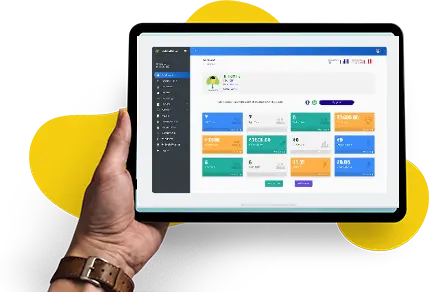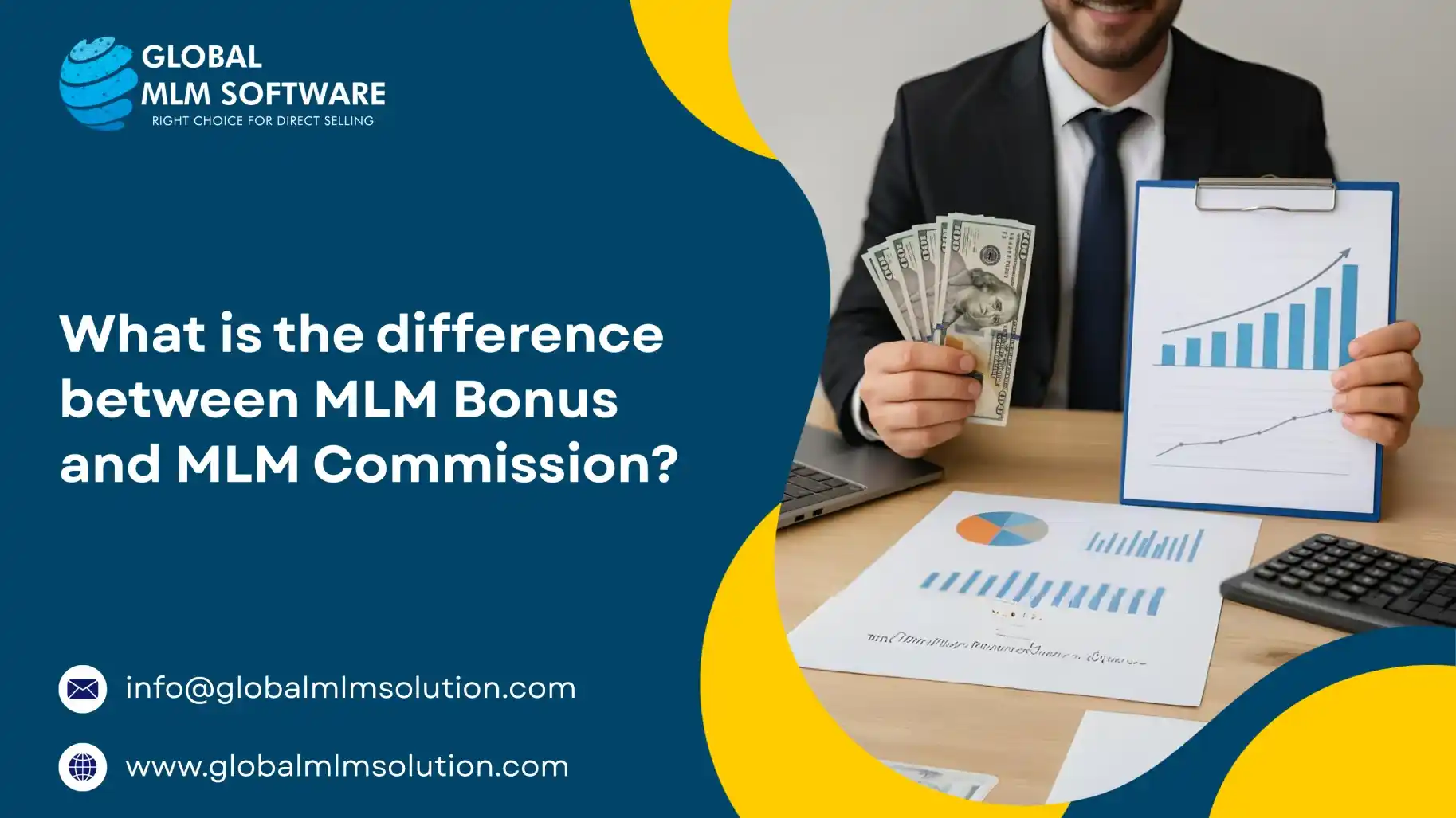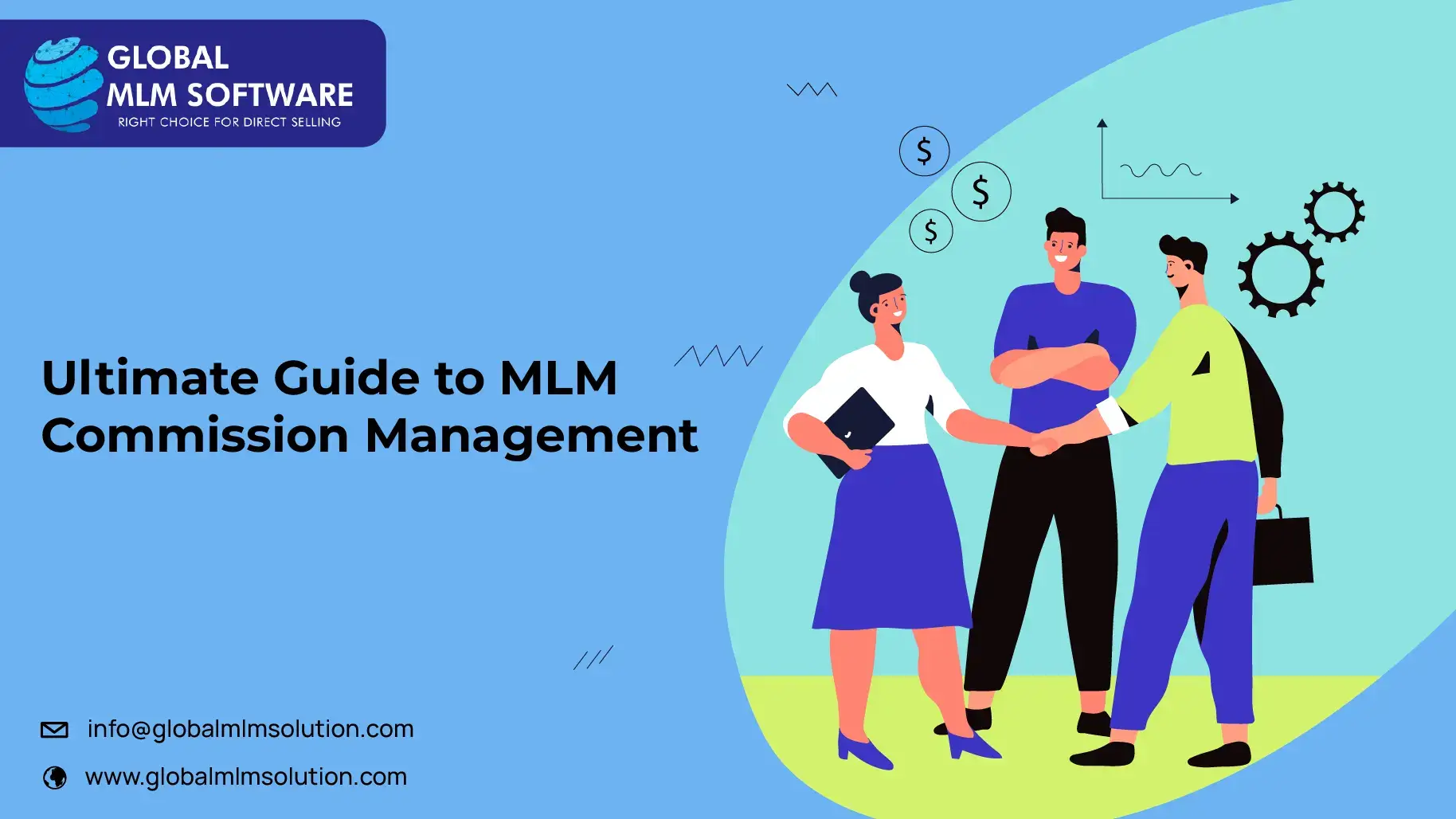MLM bonuses are an extra reward that distributors can earn on top of their regular commissions. While commissions cover the basics of product sales, bonuses go a step further and include things like rank advancements, leadership pools, and team-building incentives.
In this MLM bonus guide, we will explain the different types of bonuses, their functions, and take a look at the MLM bonus structure of a well-known MLM brand. In the end, you will have a clearer idea of what an MLM bonus plan is and how to use it to incentivize your distributor network.
This Article Contains:
What is an MLM Bonus?
An MLM bonus is a reward given to distributors based on their performance. It’s designed to encourage actions like driving sales, recruiting, or growing a team. MLM Companies usually have clear criteria in place to earn these bonuses.
A well-planned MLM bonus system can boost recruitment, keep distributors active, and help them move up ranks by rewarding their efforts.
For example,
Distributor Steve joins a weight loss MLM company, “Fit+”.
The company offers a $100 Fast Start Bonus to any distributor who recruits 3 new members within 30 days, with each recruit purchasing the $75 starter kit.
Steve successfully signs up 3 new distributors within the timeframe, all of whom also purchase the starter kit.
Therefore, Steve earns a $100 fast start bonus.
Bonuses in MLM can generally be grouped into two categories: individual bonuses and team bonuses.
Individual MLM Bonuses
These bonuses are earned based on a distributor’s personal efforts, such as achieving high sales or personally sponsoring recruits. They are great for recognizing those who take charge, put in the effort, and stay motivated to grow on their own.
Team MLM bonuses
Team MLM bonuses are earned through the performance of a distributor’s downline or team. They reward the leaders who support, guide, and grow their teams.
How do MLM Bonuses function in compensation plans?
Multi-level marketing bonuses are a significant part of MLM rewards. They are designed to go beyond regular commissions, providing extra incentives that drive distributor performance and company growth.
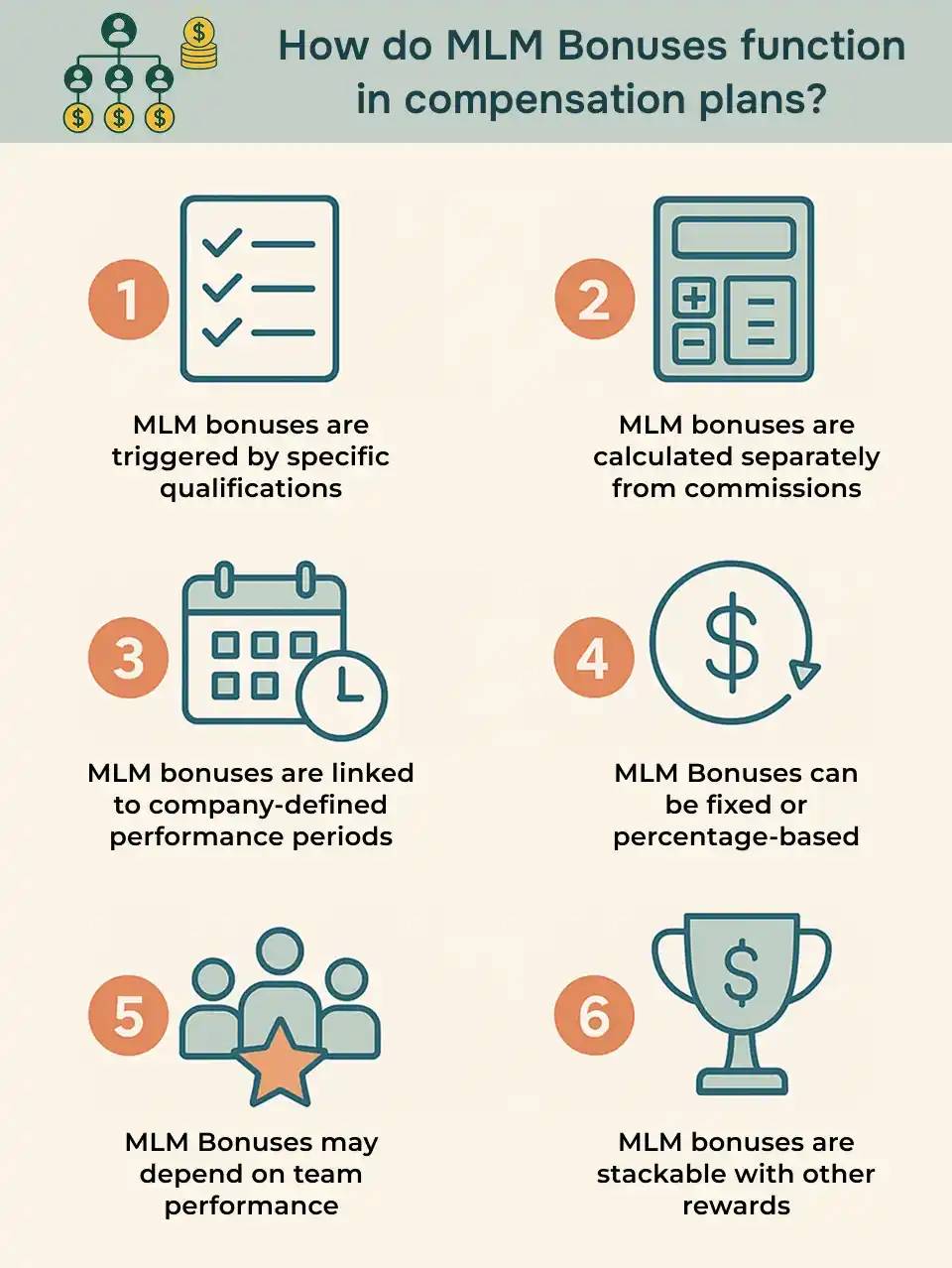
1) MLM bonuses are triggered by specific qualifications
MLM bonuses are only paid when a distributor meets certain requirements, such as achieving a new rank, hitting a sales target, or building a balanced team structure. This highlights the difference between MLM commissions and bonuses, as commissions come from regular sales activity, while bonuses reward specific achievements.
2) MLM bonuses are calculated separately from commissions
Unlike MLM commissions, which are tied to ongoing sales, network marketing bonuses are often one-time or periodic payments calculated based on the criteria set by the company.
3) MLM bonuses are linked to company-defined performance periods
Many MLM bonuses are time sensitive, meaning they are awarded based on performance in a fixed time frame. For example, fast start bonuses have a term period of 30/60/90 days from the date the distributor joins.
4) MLM Bonuses can be fixed or percentage-based:
Some MLM compensation bonuses are fixed amounts for achieving a milestone, while others are calculated as a percentage of sales, team volume, or company-wide revenue.
5) MLM Bonuses may depend on team performance
Leadership or generational bonuses are often paid based on the achievements of a distributor’s downline and not just from their own performance.
6) MLM bonuses are stackable with other rewards
A distributor can qualify for multiple types of bonuses in the same period, significantly increasing their total earnings.
Types of MLM Bonuses
There are various bonuses that can be included in an MLM compensation plan. Each of these serves a specific purpose, whether it's encouraging personal sales, rewarding team growth, or recognizing leadership achievements.
| Sl No | Multi-level Marketing Bonus Type | What It Is | Benefits | Applicable to which MLM plan |
|---|---|---|---|---|
| 1 | Fast Start Bonus | A one-time reward for new distributors who achieve certain sales or recruitment goals quickly. | Encourages quick action and faster onboarding success. | All MLM Plans |
| 2 | Sponsor Bonus | Paid to the distributor who personally recruits a new member. | Motivates active recruitment and personal engagement. | All MLM Plans |
| 3 | Pairing Bonus | Earned when the sales volume is balanced across two legs in binary plans. | Promotes balanced team growth and stronger downline stability. | Binary MLM Plan |
| 4 | MLM Matching Bonus | A percentage of the bonuses earned by distributors on the sales of their personally sponsored members. | Encourages mentoring and leadership development. | All MLM plans excluding Generation MLM Plan |
| 5 | Rank Advancement Bonus | A fixed payout when a distributor achieves a new rank. | Rewards consistency and motivates leaders to aim higher. | All MLM Plans |
| 6 | Party Bonus | Given for hosting product parties or gatherings. | Boosts retail sales, creates community engagement, and spreads product awareness. | Party MLM Plan |
| 7 | Infinity Bonus | Commissions are paid on sales beyond a certain level, often with unlimited depth. | Rewards leaders for deep network growth and long-term stability. | Unilevel MLM Plan |
| 8 | Roll-up/Compression Bonus | When inactive or non-qualified members’ earnings roll up to the active upline. | Ensures earnings stay within active leaders, motivating distributors to remain qualified. | Binary and Unilevel MLM Plans |
| 9 | Leadership Pool Bonus | A share of company-wide sales volume allocated to top-ranking leaders. | Rewards long-term efforts and aligns leaders with company growth. | All MLM Plans |
| 10 | Position Bonus | Given to distributors who successfully place members in their matrix. | Increases earnings potential and encourages reinvestment in the business. | Matrix MLM Plan |
| 11 | Matrix Completion Bonus | Earned when a distributor fills all slots in their matrix structure. | Motivates team-building and structured growth. | Matrix MLM Plan |
| 12 | Re-entry Bonus | Rewards for re-entering the plan after reaching a cap or completing a cycle. | Provides fresh earning opportunities without losing momentum. | Board/Matrix MLM Plans |
| 13 | Generation Bonus | Paid on the sales volume of multiple generations of downline teams. | Rewards depth leadership and encourages building sustainable organizations. | Unilevel & Generation-based Plans |
| 14 | Direct Referral Bonus | Instant commission earned from direct recruits’ sales or enrollment. | Incentivizes personal recruitment and direct sponsorship. | All MLM Plans |
| 15 | Overriding Bonus | Extra commissions are paid to higher ranks for the performance of downlines. | Encourages leaders to actively support their teams. | Binary, Unilevel & Matrix Plans |
| 16 | Differential Bonus | The difference between a distributor’s commission rate and that of their downline. | Ensures leaders benefit from higher rank achievements and motivates rank climbing. | All MLM Plans |
| 17 | Cycle/Board Split Bonus | Bonus is earned when a board or cycle structure is completed and split. | Encourages teamwork and keeps the downlines active toward completion goals. | Board MLM Plan |
1) Fast Start Bonus
The Fast Start Bonus rewards new distributors for achieving specific goals within a short time frame. It is also often referred to as “Pacesetter bonus.” The window to earn this MLM bonus is usually the first 30 to 90 days of joining and may vary depending on company policies.
A new distributor may earn a fast start bonus by placing orders of a certain PV (point value) or by recruiting a set number of new members within the qualifying period. The idea is to reward quick action and early momentum.
For example,
Steve joins a new wellness MLM, Fit+, as a distributor.
According to Fit+’s fast start bonus policy, he needs to place an order for $1000 worth of products and introduce two new members into his team within the first 60 days to earn a bonus of $250.
So Steve gets to work.
He eventually manages to sell products worth $1000 and introduces two new members, Lisa and Ana, into his downline.
He receives the $250 fast start bonus, which motivates him to keep up the momentum he has created early on in his journey.
2) Sponsor Bonus
A sponsor bonus is a reward paid to a distributor when they personally enroll a new member into the network. Often, this bonus is tied to sales of starter kits or initial product orders made by the new member.
The amount of sponsor bonuses can vary. While some MLM companies award a fixed amount per recruit, others set a percentage based on the new recruit’s first purchase of products or a starter pack.
This MLM distributor bonus ensures that the distributors are proactive by recruiting and growing their network directly.
For example:
Distributor Steve has already joined a wellness MLM, Fit+.
He later invites his friend David to the business, who signs up and purchases a starter kit worth $250.
Now, Fit+ provides a 20% sponsor bonus on the starter kit amount, which means Steve earns $50 right away.
3) Pairing Bonus
This bonus is often seen in binary MLM plans, where distributors are encouraged to create two balanced teams, called left and right legs. They earn a pairing bonus whenever the sales volumes of the two legs match according to the ratios set by the company.
In most cases, companies use pairing ratios. The most common is 1:1, where there is equal volume on both sides. However, achieving matching sales volume can become challenging in larger networks, so they use ratios like 1:2 or 2:1, where the volume is higher on either side, but can still trigger a matching bonus.
When the volume on both legs matches the ratio, the pairing bonus is triggered. Usually, the bonus amount is a set percentage of the weaker leg’s sales volume. Most companies also set maximum bonus limits per day, week, or month to maintain fairness and financial stability.
For example:
Steve is a part of the wellness MLM Fit+, which employs the binary MLM plan, with a pairing ratio of 1:1
According to this, Steve needs to build two teams, the left and the right leg, and balance the sales volume on both teams to receive a pairing bonus.
He sponsors David into the business and places him on his left leg.
Shortly after, he recruits John and places him on his right leg.
After a few days, both David and John sell products worth $500.
This balance of sales volume on both legs satisfies the 1:1 ratio and helps Steve earn a 10% pairing bonus, which is $50.
4) MLM Matching Bonus
A distributor receives a matching bonus, which is a percentage of sales commissions made by their downlines. This bonus rewards leaders for supporting and developing their teams, as they earn a share of the income generated by the team.
MLM companies often set a limit on the number of levels a distributor can earn matching bonuses from. This helps them maintain a sustainable payout structure. Also, matching bonus percentages may increase based on the distributor ranks.
For example:
Steve is part of a wellness MLM, Fit+.
He has David and John in his downline.
David sells products worth $500 in a month and earns commission for those sales.
Since Steve is David’s upline, he receives a 5% matching bonus on the commission earned by David.
So if David earns 10% commissions on the $500 worth of sales, his commission is $50. Now Steve earns 5% of this $50, which is $2.50.
This may seem small at first. However, when Steve’s downline grows with multiple active team members, these matching bonuses can become a significant portion of his passive income.
5) Rank Advancement Bonus
This MLM bonus is a one-time reward given to a distributor for achieving a new rank in the compensation plan. Eligible distributors receive this bonus when they advance in ranks by meeting the criteria set by the company, like achieving specific personal sales volume, group volume, or team size.
The amount of rank advancement bonuses can vary, based on the rank achieved. Higher ranks often come with larger bonuses. Some companies may also require distributors to maintain the newly achieved rank for a certain period to qualify for the full bonus.
Often, the rank advancement bonus is confused with rank-based commissions. Rank advancement bonuses are paid once when a distributor achieves a new rank. Then, the rank he achieves makes him qualified to receive higher percentages of commissions, based on the company’s rules.
For example:
Steve has been with Fit+ for over 3 years.
Over time, he has built a large and active team.
He recently achieved the “Team Builder” rank, which requires maintaining at least 10 active recruits and generating a minimum of $5,000 in team sales within a month for 5 consecutive months.
The company provides him with a one-time rank advancement bonus of $250.
This new rank comes with increased commission percentages and other incentives based on the company's policies.
6) Party Bonus
The party bonus is typically provided by MLM companies that follow the party MLM plan model. In this model, agents or consultants host online or offline demos where they showcase the products and create a relaxed environment for selling.
Consultants hosting such parties become eligible to receive a party bonus if the total sales generated during the party exceed the company’s set target. This bonus can be a fixed amount or a percentage of the sales.
For instance,
Emily joins a party MLM business selling candles.
According to the company rules, party hosts receive a 10% party bonus on the total sales volume achieved in the party if the sales exceed $1000.
So Emily gets to work and plans to host a party at her residence.
She invites 30 of her contacts. While 26 of them attend, the party becomes a huge success, as Emily receives $1,230 worth of orders.
This makes her eligible for a 10% party bonus, which is $123, as per the company's policies.
7) Infinity Bonus
The infinity bonus is a recurring reward reserved for the elite, or the top-ranking distributors, who have built extensive and active teams.
When distributors qualify for this bonus, they earn a small percentage of the commissionable volume of their entire downline, often between 0.5% and 1% for all the months that they remain eligible.
The specialty of the infinity bonus is that it pays beyond the usual commission levels. While most MLM bonuses are restricted to a certain level, infinity bonuses reward distributors for sales generated in many levels, sometimes infinite levels, hence the name.
However, MLM companies establish specific rules for this bonus. Distributors should constantly maintain the personal volume/group volume requirements to be eligible for the bonus.
Also, the eligibility continues only until another distributor reaches the same level. If this happens, the former distributor’s percentage is either reduced or stopped entirely, depending on company policies.
For example,
Steve is a distributor for the wellness MLM, Fit+ .
After being an active distributor for 5-6 years, he finally moved up to the “President” rank.
According to the company rules, Steve is now eligible for the infinity bonus.
He receives 1% of the commission volume generated by his entire downline. So if his cumulative downline sales volume is $850,000 in a given month, his infinity bonus would be: 1% of $850,000 = $8,500.
He keeps receiving this amount for as long as he maintains his rank.
But Fit+’s compensation policy also states that Steve can only continue receiving the bonus as long as no other leader qualifies for the same.
However, things take a turn when Steve’s star recruit, Linda, climbs the ranks and reaches the President level.
Since Linda is also qualified for the infinity bonus, Steve may either stop receiving the infinity bonus, or it will be split equally between both if Steve continues to be eligible. But it ultimately depends on the company's policies.
If the company splits the infinity bonus between Steve and Linda, then each will get 0.5% of the total sales volume.
8) Roll-up or Compression Bonus
Sometimes, a distributor fails to meet the minimum qualifications set by the company to receive a payout. In such cases, the system “compresses” the inactive or non-qualified member, and the sales volume achieved by them moves to the next qualified upline distributor.
This ensures that non-active members are removed from the system and active, engaged members are constantly rewarded for their efforts.
For example:
Steve is a distributor for the wellness MLM Fit+, with a downline of 45 members.
According to the company policies, each distributor should reach the monthly PV of 500 to remain active and be eligible for payouts.
However, one of Steve’s frontline members, Kathy, couldn’t reach the minimum monthly requirement due to personal reasons. Instead, she could only achieve 300 PV.
If the company provides 15% commissions on the PV, then the payout amount is $45.
Since Kathy is not eligible to receive her payout, this $45 moves upward to the next eligible distributor, in this case, Steve.
9) Leadership Pool Bonus
The leadership pool bonus is a performance-based incentive allocated to the top-ranking distributors of the company. MLM companies typically allocate a percentage of their global sales for the leadership pool.
The total amount is divided into shares, and the number of shares each distributor gets depends on their rank. Higher ranks may receive two or more shares, while lower ranks may receive just one share.
Also, the actual payout from a leadership pool can fluctuate from period to period, depending on the company’s global sales and the number of qualifying distributors. Moreover, distributors will receive a share of the leadership pool as long as they remain qualified for the eligible ranks.
For example:
Steve is a distributor with the wellness MLM Fit+.
After 5 years, he finally advanced to the “Executive Director” rank, which makes him qualified for the leadership bonus pool.
This bonus pool is funded by 2% of the company’s total annual sales, which is shared among all distributors at the Executive Director rank and higher.
The company reported a revenue of $4 million in total sales in the year Steve qualified for the rank. So, 2% of that is $80,000.
This $80,000 is further divided into shares. Suppose there are 100 total shares, each is worth $800.
According to company policies, distributors in the executive rank receive one share.
So, Steve receives $800 from the leadership bonus pool for that year.
10) Position Bonus
A position bonus is exclusive to the matrix MLM plan. A distributor receives it when they successfully place a newly sponsored member within their matrix. This bonus is generally a fixed amount and rewards distributors for building and completing a matrix structure.
However, it comes with a condition. The newly sponsored member should be placed within the distributor’s matrix to receive the bonus. If, in any case, this doesn’t happen due to spillover rules, forced placement limits, or no available spots in the matrix, the distributor will not receive the bonus.
For example,
Steve is a distributor for the wellness MLM Fit+, which employs the 2X3 matrix MLM structure. This means that each distributor can recruit two people under them, and the matrix will have three levels.
This means Steve has 15 positions to fill within the matrix.
The company also offers a position bonus of $25 for the successful placement of recruits within the matrix.
One day, Steve introduces Maya into his 2x3 matrix.
She is successfully placed in the second level, and Steve earns a matrix bonus of $25.
But if Maya ends up outside of Steve’s matrix due to overflow, Steve may miss out on the bonus, despite personally sponsoring her.
11) Matrix Completion Bonus
As the name suggests, the matrix completion bonus is earned when a distributor fills all the available positions in a matrix MLM structure. It is a one-time bonus and is often a fixed amount set by the company.
For example:
Steve is a distributor for a wellness MLM, Fit+, which employs the 2X3 matrix structure. This means that each distributor can recruit two people under them, and the matrix will have three levels.
So, to complete the matrix, Steve needs to fill 15 positions.
After a lot of focused efforts and help from his downline, he finally fills all the positions and completes the matrix.
As a result, Fit+ awards him with a Matrix completion bonus of $450.
12) Re-Entry Bonus
This kind of MLM bonus is typically associated with Board or Matrix plans. If the downline member of a distributor completes their matrix structure by filling all the positions, they often have the option to re-enter a new matrix or a board.
In this case, the sponsor of that particular distributor earns a re-entry bonus. This bonus encourages distributors to support and mentor their downline members to complete their matrices. On the other hand, the distributor who completes the matrix will receive a matrix completion bonus, thus benefiting both parties.
For example:
Steve is a distributor for the wellness MLM that employs the 3X5 matrix. This means that each distributor can recruit three people under them, and the matrix will have five levels.
So the total positions in Steve’s matrix are 364, so he needs to recruit 364 people to complete his matrix.
One of Steve’s downlines, Jenna, also has 364 positions in her matrix.
After a few months, Jenna completes her matrix and is offered a re-entry position in a new matrix.
Fit+ offers $500 as a re-entry bonus. So since Jenna completed her matrix, her upline/sponsor, Steve, receives this bonus.
13) Generation Bonus
This bonus pays distributors for helping their team members become leaders. When a downline distributor reaches a certain rank, they and their downline may be considered a new generation within the upline distributor’s overall network.
The network of an MLM company may have many such generations. However, the distributor’s leadership title determines the number of generation bonuses they will receive.
Generation bonuses are calculated as a percentage of the sales volume of each generation. Also, the percentage of generation bonuses decreases as the generations go deeper.
For example:
Steve is a platinum rank distributor with the wellness MLM, Fit+.
One of his downline members, Sarah, builds a strong team and becomes a Gold leader. This becomes generation 1 under Steve’s network.
Further down in Steve’s network, another member, John, becomes a silver leader.
Now, John and his team become Steve’s generation 2.
Another member in Steve’s downline, Kathy, becomes a “Team Leader”, which forms Steve’s generation 3.
The table below shows the company’s generation bonus percentages for each level, and Steve’s overall earnings from the three generations in his team.
| Generation | Leader | Team Sales Volume (BV) | Bonus % | Steve’s Earnings |
|---|---|---|---|---|
| 1 | Sarah (Gold Leader) | $8,000 | 5% | $400 |
| 2 | John (Silver Leader) | $6,000 | 3% | $180 |
| 3 | Kathy (Team Leader) | $4,500 | 2% | $90 |
| Total | — | $18,500 | — | $670 |
14) Direct Referral Bonus
A distributor receives a direct referral bonus when they personally recruit someone into their downline. It can be a fixed amount or a percentage of the new recruit’s first purchase.
For example:
Steve is a distributor with a wellness MLM, Fit+.
He recruits a new member, Daisy, into his downline.
Daisy purchases a $330 starter pack.
Assuming the company offers a 10% direct referral bonus, Steve instantly receives $33.
15) Overriding Bonus
The overriding bonus is another leadership-level reward received by higher-ranking distributors based on the sales performance of their team or downline.
It is typically calculated as a percentage of the team’s sales volume. Also, the percentage rate can be a flat rate or a tiered system, which increases as the team reaches higher sales targets.
For example:
Steve has been a distributor at the wellness MLM, Fit+, for over 3 years and has a large downline team.
His team recently achieved 20,000 PV. According to the company rules, this makes Steve eligible for the overriding bonus of 5%.
He receives $1,000 as an overriding bonus.
16) Differential Bonus
This is a type of MLM bonus where a distributor earns the difference between their own commission rate and that of their downline. As distributors climb up in ranks, they receive greater percentages of commissions, unlocking higher differential bonuses.
For example,
Steve is a distributor for a wellness MLM, Fit+.
If Steve is eligible for a 12% commission and his downline member, Anna, is at a level that earns her 7%, Steve will receive the 5% difference on Anna’s sales.
So, if Anna generates $4,000 in sales volume, Steve earns 5% of $4,000 = $200 as his differential bonus.
17) Cycle/ Board Split Bonus
Cycle or Board split bonuses are rewards distributors earn when they complete a specific group structure or “cycle,” and enter a new board. This type of bonus is often seen on board MLM plans, or commonly referred to as a revolving matrix plan.
Unlike other bonuses, this type of bonus is more structure-based than PV-based. It works well for MLM businesses looking for faster growth of their MLM network.
For example:
Emma joins an MLM that uses a 3x2 board system. This means that each distributor can recruit three members, and there will be 2 levels on the board.
So, this board has distributor Emma in the top position; she recruits 3 members, who will form level 1 of the board.
Each of them recruits 3 more people, filling up all 9 spots in the second level.
Once all 12 spots are filled, Emma completes the cycle.
She earns a $300 cycle/board split bonus and is placed into a new board.
Things to Take Care of While Defining MLM Bonuses
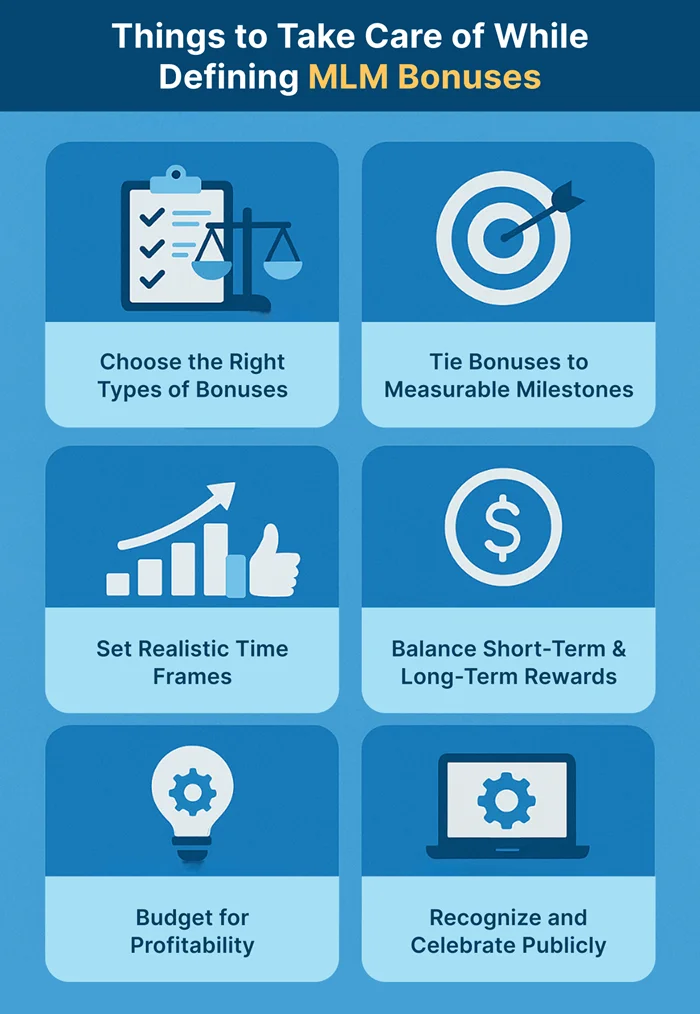
Defining MLM bonuses for your MLM business is just as important as setting commissions. A well-structured bonus MLM plan can spark motivation, drive sales, and create a healthy competitive environment among distributors. Here are the key things you should keep in mind when creating your MLM bonus structure:
1) Choose the Right Types of Bonuses
Decide which bonuses you want to include in your MLM compensation plan based on your short and long-term business objectives. Each type serves a different purpose. For example, fast-start bonuses encourage quick action from new distributors, while leadership bonuses reward long-term team building.
2) Tie Bonuses to Measurable Milestones
Make sure bonuses are linked to clear, trackable goals like achieving a certain rank, hitting monthly sales targets, or building a specific team structure. Avoid vague criteria that can cause disputes or confusion.
3) Set Realistic Time Frames
Bonuses should have time limits that create urgency without making goals impossible. For example, a 90-day fast-start bonus can motivate quick onboarding, while annual leadership bonuses reward consistent performance.
4) Balance Short-Term and Long-Term Rewards
Short-term incentives like pacesetter bonuses result in higher initial engagement from new distributors, while long-term bonuses, like annual leadership pools, build loyalty and retention. A healthy mix keeps momentum steady.
5) Budget for Profitability
Work out exactly how much of your revenue can safely go toward your MLM bonus structure. Overly generous bonuses might excite distributors, but could hurt your company’s financial stability.
6) Recognize and Celebrate Publicly
The way you present a bonus is as important as the bonus itself. Announcing winners in company events or newsletters makes the reward more meaningful and inspires others to aim for it.
Case Study: A Look into the MLM Bonus System of Some Popular MLM Companies
Every MLM company puts its own spin on bonuses, but the idea is to keep people motivated. Here, we have taken some of the bonuses that Young Living, MONAT Global, and LiveGood offer as part of their compensation plans.
1) Young Living:
Fast start bonus of up to 25% of Product Value (PV) on sales (up to 1,000 PV) for a newly enrolled Customer or Brand Partner during their first three calendar months.
Rank Achievement Bonus is awarded to members from Senior Star to Silver rank. They receive between $100- $200 for every month that they maintain their ranks.
Generational leadership bonus, which is a portion (6.25%) of Young Living’s global Commissionable Volume, is allocated to rank-based “shares” and distributed monthly to eligible leaders at the Executive level or higher.
Shares paid per rank vary (e.g., Executive = 1 share; Gold = 2; Platinum and above = 2–3 shares), with a maximum cap of $100,000 per Brand Partner per month.
2) MONAT Global:
Rank advancement bonus starting from $150 for Managing Market Partner, increasing up to $500 for Managing Market Builder.
Generation 1 bonus of 4% for the Associate rank, moving to a generation 5 bonus of 4% for the Senior Executive Director rank.
3) LiveGood:
Matching Bonuses up to 50% for personally enrolled 1st generation members, 10% for 2nd generation, and 5% for 3rd generation.
If you are structuring MLM bonuses for your business, make sure to maintain a balance between short-term and long-term bonuses. New distributors get the instant motivation they need through fast start and rank advancement bonuses, while seasoned leaders are encouraged to stick around and build through deeper, generational rewards.
It’s this blend of short-term wins and long-term vision that keeps teams engaged, leaders motivated, and businesses growing steadily.
Understanding the Big Picture of MLM Earnings
In the multi level marketing industry, MLM bonuses are powerful motivators that drive performance, loyalty, and long-term growth from your distributor network.
Moreover, MLM bonuses are not just about cash rewards anymore but also include lifestyle-driven incentives such as luxury trips, recognition programs, and even the coveted MLM car bonus, which has become a symbol of achievement and prestige for top performers.
These rewards create a sense of aspiration, strengthen loyalty, and motivate distributors to aim higher within the company’s structure.
In the end, your MLM bonus structure should have a perfect combination of financial rewards and lifestyle perks, ensuring that distributors feel both recognized and motivated. You just have to plan your payouts in a way that provides sustainable growth for the company while keeping the distributor network energized and inspired to achieve more.
FAQs
1. What is a sponsor bonus?
A sponsor bonus is paid to a distributor when they personally enroll a new member into their downline.
2. How can I ensure MLM bonuses stay compliant with regulations?
The easiest way to do this is to keep your MLM bonuses tied to sales, not recruitment. A transparent network marketing commission structure that focuses on real customer value will also help you stay on the right side of the law.
References
-
MLM.com
-
Researchgate.net
Disclaimer: Global MLM Software does not endorse any companies or products mentioned in this article. The content is derived from publicly available resources and does not favor any specific organizations, individuals or products.


